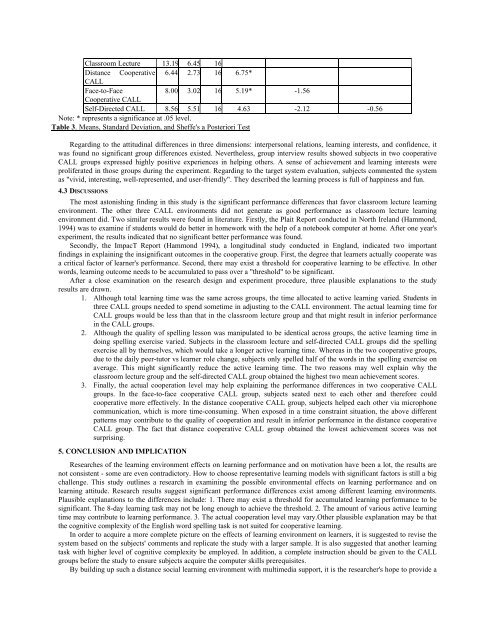ED-MEDIA 1999 Proceedings Book - Association for the ...
ED-MEDIA 1999 Proceedings Book - Association for the ...
ED-MEDIA 1999 Proceedings Book - Association for the ...
Create successful ePaper yourself
Turn your PDF publications into a flip-book with our unique Google optimized e-Paper software.
Classroom Lecture 13.19 6.45 16<br />
Distance Cooperative 6.44 2.73 16 6.75*<br />
CALL<br />
Face-to-Face<br />
8.00 3.02 16 5.19* -1.56<br />
Cooperative CALL<br />
Self-Directed CALL 8.56 5.51 16 4.63 -2.12 -0.56<br />
Note: * represents a significance at .05 level.<br />
Table 3. Means, Standard Deviation, and Sheffe's a Posteriori Test<br />
Regarding to <strong>the</strong> attitudinal differences in three dimensions: interpersonal relations, learning interests, and confidence, it<br />
was found no significant group differences existed. Never<strong>the</strong>less, group interview results showed subjects in two cooperative<br />
CALL groups expressed highly positive experiences in helping o<strong>the</strong>rs. A sense of achievement and learning interests were<br />
proliferated in those groups during <strong>the</strong> experiment. Regarding to <strong>the</strong> target system evaluation, subjects commented <strong>the</strong> system<br />
as "vivid, interesting, well-represented, and user-friendly". They described <strong>the</strong> learning process is full of happiness and fun.<br />
4.3 DISCUSSIONS<br />
The most astonishing finding in this study is <strong>the</strong> significant per<strong>for</strong>mance differences that favor classroom lecture learning<br />
environment. The o<strong>the</strong>r three CALL environments did not generate as good per<strong>for</strong>mance as classroom lecture learning<br />
environment did. Two similar results were found in literature. Firstly, <strong>the</strong> Plait Report conducted in North Ireland (Hammond,<br />
1994) was to examine if students would do better in homework with <strong>the</strong> help of a notebook computer at home. After one year's<br />
experiment, <strong>the</strong> results indicated that no significant better per<strong>for</strong>mance was found.<br />
Secondly, <strong>the</strong> ImpacT Report (Hammond 1994), a longitudinal study conducted in England, indicated two important<br />
findings in explaining <strong>the</strong> insignificant outcomes in <strong>the</strong> cooperative group. First, <strong>the</strong> degree that learners actually cooperate was<br />
a critical factor of learner's per<strong>for</strong>mance. Second, <strong>the</strong>re may exist a threshold <strong>for</strong> cooperative learning to be effective. In o<strong>the</strong>r<br />
words, learning outcome needs to be accumulated to pass over a "threshold" to be significant.<br />
After a close examination on <strong>the</strong> research design and experiment procedure, three plausible explanations to <strong>the</strong> study<br />
results are drawn.<br />
1. Although total learning time was <strong>the</strong> same across groups, <strong>the</strong> time allocated to active learning varied. Students in<br />
three CALL groups needed to spend sometime in adjusting to <strong>the</strong> CALL environment. The actual learning time <strong>for</strong><br />
CALL groups would be less than that in <strong>the</strong> classroom lecture group and that might result in inferior per<strong>for</strong>mance<br />
in <strong>the</strong> CALL groups.<br />
2. Although <strong>the</strong> quality of spelling lesson was manipulated to be identical across groups, <strong>the</strong> active learning time in<br />
doing spelling exercise varied. Subjects in <strong>the</strong> classroom lecture and self-directed CALL groups did <strong>the</strong> spelling<br />
exercise all by <strong>the</strong>mselves, which would take a longer active learning time. Whereas in <strong>the</strong> two cooperative groups,<br />
due to <strong>the</strong> daily peer-tutor vs learner role change, subjects only spelled half of <strong>the</strong> words in <strong>the</strong> spelling exercise on<br />
average. This might significantly reduce <strong>the</strong> active learning time. The two reasons may well explain why <strong>the</strong><br />
classroom lecture group and <strong>the</strong> self-directed CALL group obtained <strong>the</strong> highest two mean achievement scores.<br />
3. Finally, <strong>the</strong> actual cooperation level may help explaining <strong>the</strong> per<strong>for</strong>mance differences in two cooperative CALL<br />
groups. In <strong>the</strong> face-to-face cooperative CALL group, subjects seated next to each o<strong>the</strong>r and <strong>the</strong>re<strong>for</strong>e could<br />
cooperative more effectively. In <strong>the</strong> distance cooperative CALL group, subjects helped each o<strong>the</strong>r via microphone<br />
communication, which is more time-consuming. When exposed in a time constraint situation, <strong>the</strong> above different<br />
patterns may contribute to <strong>the</strong> quality of cooperation and result in inferior per<strong>for</strong>mance in <strong>the</strong> distance cooperative<br />
CALL group. The fact that distance cooperative CALL group obtained <strong>the</strong> lowest achievement scores was not<br />
surprising.<br />
5. CONCLUSION AND IMPLICATION<br />
Researches of <strong>the</strong> learning environment effects on learning per<strong>for</strong>mance and on motivation have been a lot, <strong>the</strong> results are<br />
not consistent - some are even contradictory. How to choose representative learning models with significant factors is still a big<br />
challenge. This study outlines a research in examining <strong>the</strong> possible environmental effects on learning per<strong>for</strong>mance and on<br />
learning attitude. Research results suggest significant per<strong>for</strong>mance differences exist among different learning environments.<br />
Plausible explanations to <strong>the</strong> differences include: 1. There may exist a threshold <strong>for</strong> accumulated learning per<strong>for</strong>mance to be<br />
significant. The 8-day learning task may not be long enough to achieve <strong>the</strong> threshold. 2. The amount of various active learning<br />
time may contribute to learning per<strong>for</strong>mance. 3. The actual cooperation level may vary.O<strong>the</strong>r plausible explanation may be that<br />
<strong>the</strong> cognitive complexity of <strong>the</strong> English word spelling task is not suited <strong>for</strong> cooperative learning.<br />
In order to acquire a more complete picture on <strong>the</strong> effects of learning environment on learners, it is suggested to revise <strong>the</strong><br />
system based on <strong>the</strong> subjects' comments and replicate <strong>the</strong> study with a larger sample. It is also suggested that ano<strong>the</strong>r learning<br />
task with higher level of cognitive complexity be employed. In addition, a complete instruction should be given to <strong>the</strong> CALL<br />
groups be<strong>for</strong>e <strong>the</strong> study to ensure subjects acquire <strong>the</strong> computer skills prerequisites.<br />
By building up such a distance social learning environment with multimedia support, it is <strong>the</strong> researcher's hope to provide a
















